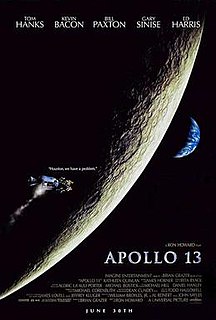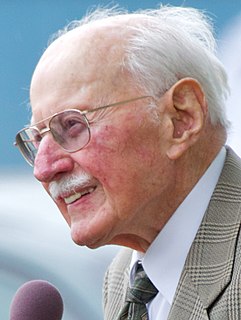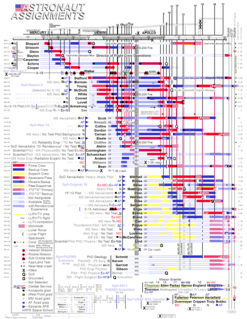
The OC-135B Open Skies United States Air Force observation aircraft supports the Treaty on Open Skies. The aircraft, a modified WC-135B, flies unarmed observation flights over participating parties of the treaty. Three OC-135B aircraft were modified by the Aeronautical Systems Center's 4950th Test Wing at Wright-Patterson Air Force Base in Ohio. The first operationally-capable OC-135B was assigned to the 24th Reconnaissance Squadron at Offutt AFB in October 1993. It is now fitted with a basic set of navigational and sensor equipment, and was placed in inviolate storage at the Aerospace Maintenance and Regeneration Center at Davis-Monthan Air Force Base near Tucson, Arizona in 1997. Two fully operational OC-135B aircraft were delivered in 1996 with the full complement of treaty-allowed sensors, which includes an infrared line scanner, synthetic aperture radar and video scanning sensors.

Apollo 13 is a 1995 American space docudrama film directed by Ron Howard and starring Tom Hanks, Kevin Bacon, Bill Paxton, Gary Sinise, and Ed Harris. The screenplay by William Broyles Jr., and Al Reinert dramatizes the aborted 1970 Apollo 13 lunar mission and is an adaptation of the book Lost Moon: The Perilous Voyage of Apollo 13 by astronaut Jim Lovell and Jeffrey Kluger. The film depicts astronauts Lovell, Jack Swigert, and Fred Haise aboard Apollo 13 for America's third Moon landing mission. En route, an on-board explosion deprives their spacecraft of most of its oxygen supply and electric power, forcing NASA's flight controllers to abort the Moon landing, and turning the mission into a struggle to get the three men home safely.

James Arthur Lovell Jr. is a former NASA astronaut, Naval Aviator, and retired Navy captain. Lovell is known for being the commander of the ill-fated Apollo 13 mission, which suffered a critical failure en route to the Moon but was brought back safely to Earth through the efforts of the crew and mission control. In addition to being part of the Apollo 13 crew, Lovell was the command module pilot of Apollo 8, the first Apollo mission to enter lunar orbit.

The Distinguished Flying Cross is a military decoration awarded to any officer or enlisted member of the United States Armed Forces who distinguishes himself in support of operations by "heroism or extraordinary achievement while participating in an aerial flight, subsequent to November 11, 1918."

Wing Commander is a media franchise consisting of space combat simulation video games from Origin Systems, Inc., an animated television series, a feature film, a collectible card game, a series of novels, and action figures. The franchise originated in 1990 with the release of Wing Commander.
Wing Commander may refer to:

Robert Anderson "Bob" Hoover was a United States Army Air Forces fighter pilot, USAF and civilian test pilot, flight instructor, air show pilot, and aviation record-setter. Known as the "pilot's pilot", Hoover revolutionized modern aerobatic flying and in many aviation circles has been called as one of the greatest pilots ever to have lived.

NASA's Astronaut Group 2, also known as The New Nine, was the second group of astronauts selected by NASA and announced on September 17, 1962. The group was required to augment the original Mercury 7 with the announcement of the Gemini program and leading to the Apollo program. While the Original 7 had been selected to accomplish the simpler task of orbital flight, the new challenges of rendezvous and lunar landing led to the selection of candidates with advanced engineering degrees as well as test pilot experience. Two of this group had been candidates for the original 7, but were not selected then for medical reasons. In addition, Group 2 became the first group with civilian test pilots in the group; See flew for General Electric, while Armstrong flew the X-15 research plane for NASA.

NASA's Astronaut Group 5 was a group of nineteen astronauts selected by NASA in April 1966. Of the six Lunar Module Pilots that walked on the Moon, three came from Group 5. The group as a whole is roughly split between the half who flew to the Moon and the other half who flew Skylab and Shuttle, providing the core of Shuttle Commanders early in that program. This group is also distinctive in being the only time when NASA hired a person into the astronaut corps who had already earned astronaut wings, X-15 pilot Joe Engle. John Young labelled the group the "Original Nineteen" in parody of the original seven Mercury astronauts.

Astronaut Group 7, referred to in some documents as the USAF MOL Transfer, was a group of seven astronauts announced by NASA on August 14, 1969, and was the last group to be selected during the Apollo era. After the USAF Manned Orbiting Laboratory (MOL) project was cancelled, NASA hired seven of the astronauts selected for that program to form this "Group 7", roughly the younger half of the MOL astronauts. By the time they joined NASA, all Apollo flight assignments had been lined up, but four were given non-flying support assignments for Apollo. Others were also given support assignments for Skylab and the Apollo-Soyuz Test Project, with Bobko and Crippen participating in the Skylab Medical Experiment Altitude Test. Group 7 went on to form the core of early Space Shuttle pilots, upgrading to commander after their first flight, flying 17 STS missions between them, plus the Approach and Landing Tests of Enterprise (OV-101).

No. 352 Squadron RAF was a Yugoslav-manned fighter-bomber squadron of the Royal Air Force during the Second World War. The squadron was also known as First NOVJ Squadron.
NASA Astronaut Group 12 was a group of 15 astronauts announced by NASA on June 5, 1987.
NASA Astronaut Group 10 was a group of 17 astronauts that were selected in 1984 and consisted of seven pilots and ten mission specialists. Although selected in 1984, no member of the group would fly until 1988 due to the Challenger disaster and the resulting grounding of the Space Shuttle fleet.

Flight Command is a 1940 American film about a cocky U.S. Navy pilot who has problems with his new squadron and with the wife of his commander. It stars Robert Taylor, Ruth Hussey and Walter Pidgeon. Flight Command has the distinction of often being credited as the first Hollywood film glorifying the American military to be released after the outbreak of World War II in Europe, a year before the U.S. entered the conflict.
Flat Top is a 1952 American drama war film directed by Lesley Selander and starring Sterling Hayden, with early appearances from Phyllis Coates, Jack Larson, Richard Carlson, and William Schallert. The film was nominated for the Academy Award for Best Film Editing.












